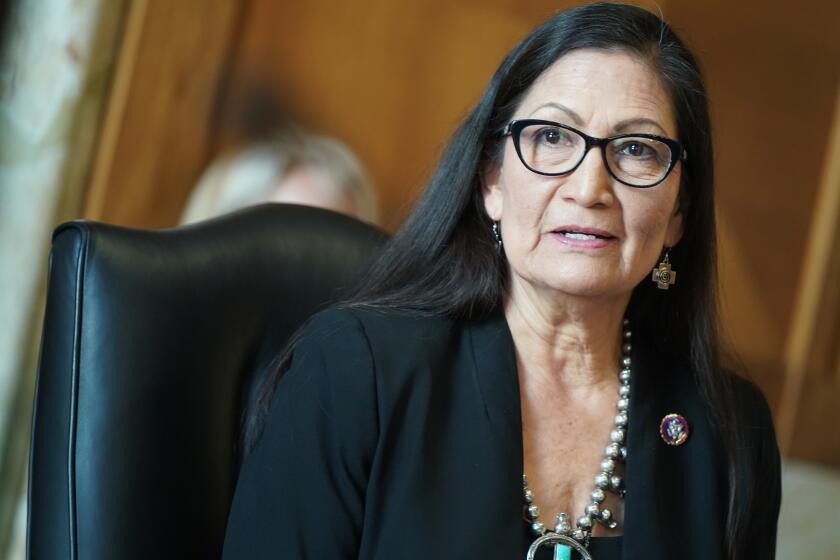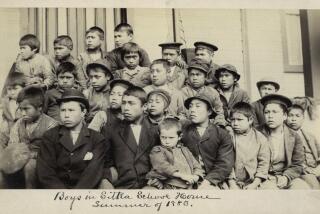How a journalist unraveled a gory founding myth of the Pacific Northwest
On the Shelf
Murder at the Mission: A Frontier Killing, Its Legacy of Lies, and the Taking of the American West
By Blaine Harden
Viking: 464 pages, $30
If you buy books linked on our site, The Times may earn a commission from Bookshop.org, whose fees support independent bookstores.
Chinua Achebe once recalled an African proverb to an interviewer: “Until the lions have their own historians, the hunt will always glorify the hunter.” His words seem to have extra resonance in these times, as Americans reckon with a version of history written by white people. Last week, officials in Washington mandated the removal from the U.S. Capitol of the statue of a man long seen as the state’s “savior,” correcting a destructive myth about how the Oregon Territory came into the United States.
Blaine Harden, whose latest book, “Murder at the Mission,” dismantles that myth, grew up in Washington, the son of a man who helped build the Grand Coulee Dam, “the mightiest thing ever built by a man,” as Woody Guthrie sang.
When we talked in early April via video, he admitted that he’d never really thought about the connection between the electricity powering his house and the history of the Columbia River. Then, he met Martin Louie Sr., a member of the Confederated Tribes of the Colville Reservation. Harden was at work on a book about the Columbia, and when he told Louie about his father, and how Harden himself had worked on the dam for a summer, Louie told him, “You’re the guys who killed our fish, and then you gave us nothing.”
The septuagenarian got up slowly from his sofa, Harden recalled, and went to his cupboard. He told Harden, “The only thing they gave us was this” — “and then he shoved a can of government-issued salmon in my face.”
The issue of tribal rights is inseparable from any discussion of water in the West, and it looks likely to come to the fore again this summer as an ongoing drought pits farmers against tribes. Unpacking the history of white settlement in the Pacific Northwest means dealing with one of the region’s founding myths: how killings at a small mission in what is now eastern Washington led to the establishment of the states of Oregon, Washington and Idaho.
Like Harden, I had my first encounter with the history of the ill-fated missionaries, Marcus and Narcissa Whitman, in a Washington school. For me, it was in the eighth grade. For Harden, it was an elementary school play about the “Whitman massacre,” the slaying of the couple and 11 other white men by a delegation from the Cayuse tribe in 1847.
In a tribute to Leslie Marmon Silko, Indigenous authors at the L.A. Times Festival of Books talk about building community in Native American writing.
The Whitmans were celebrated as martyrs, and Marcus Whitman’s cross-country journey to lobby lawmakers to claim the Oregon Territory was seen in retrospect as the single event that eventually brought the land under U.S. control. But as Harden’s research lays out, the story was spun into a golden legend by the fabulist and fellow missionary Henry Spalding. In fact, the tale of the cross-country journey bears little resemblance to historical truth. Not only did Spalding invent details that transformed Whitman into a hero but he and others also used these concocted details to raise money and found a college named in the Whitmans’ honor.
“Whitman’s story was a real-life Old West passion play — or so it seemed,” Harden writes. “Violent death at the hands of tomahawk-slinging hostiles gave the story a stirring shiver of land-stand martyrdom. It linked Whitman to General George Armstrong Custer at Little Bighorn, to Davy Crockett at the Alamo, even to Christ at Calvary. What no one told me at the time was that the Whitman story was largely a pack of lies.”
While the legend portrays the Whitmans as a couple dedicated to saving souls among the local tribes, Harden says the Boston-based Board of Commissioners of Foreign Missions, which sent the Whitmans on their mission, had an “explicit purpose [which] was to prepare tribal people for the coming of whites. To acculturate them, to convert them, and to ‘civilize’ them so they could better adapt to the coming flood of white people.”
This “civilizing” mission was a response to an increasingly harsh national policy toward Native Americans that included forced migrations such as the Trail of Tears. The missionaries “insisted that the Indians learn English, cut their hair, wear white people’s clothes, abandon their traditional nomadic lives, forsake collective ownership of land, accept private property, settle down as farmers, embrace ‘hard work,’ learn to plow, and raise row crops — all while obeying the Ten Commandments…”
Deb Haaland’s confirmation as the first Native American to lead the Interior Department inspires new hope among California’s Indigenous leaders.
When a measles outbreak started killing the Cayuse, and the Whitmans’ medicine failed to cure the ill, thus making Marcus a “failed medicine man,” the fatal events were set in motion. The mission was already failing; the Cayuse had no interest in finding white religion. The “increasingly bossy, arrogant, and selfish” missionaries built grand houses and brought herds of farm animals but refused to pay rent to the Cayuse for their lands. For the tribe, the disease they spread was the final straw, a “poisoning” of their people.
Spalding, who had settled among the Nez Perce nearby, capitalized on the killings. Harden describes him as a “conspiracy peddler, a publicity-savvy fabulist in the garb of a pioneer preacher.” Spalding dramatized his own escape from Cayuse attacks and claimed Catholic priests at the local diocese had orchestrated the killings.
Harden conveys in witty prose the consequences of Spalding’s story coming apart: a reckoning at Whitman College in Walla Walla, Wash., leading to the removal of a Marcus Whitman statue from campus and, more recently, from Statuary Hall at the U.S. Capitol.
The encounter with Louie that spawned “Murder at the Mission” came in the course of working on “A River Lost,” a book on the dams that turned the once-mighty Columbia into a series of mud puddles. Harden calls it his “most important experience as a reporter,” which is saying a lot. His long career has included stints with the Washington Post, the New York Times, PBS’ documentary series “Frontline” and the Economist. In 2012, he wrote “Escape From Camp 14,” the story of the only person known to have escaped a North Korean political prison camp. He has reported out of North Korea, war-torn Yugoslavia and many locations in Africa.
But it’s the story of the Whitmans that “shocked” Harden like none other. It also felt eminently timely, he said, “particularly in the Trump and post-Trump era, where people are willing to buy into stories that are false but make them feel good about themselves.” He draws a straight line from grade-school myths to today’s conspiracy theories. “In America,” he says, “a good story has an insidious way of trumping a true one, especially if that story confirms our virtue, congratulates our pluck, and enshrines our status as God’s chosen people.”
Annette Gordon-Reed, Ayad Akhtar, Héctor Tobar, Martha Minow, David Kaye and Jonathan Rauch discuss the Jan. 6 riot and what we do about it.
Yet Harden also sees the unraveling of the Whitman myth as a story of triumph. The Cayuse bore the stigma of the killing for more than a century, and it wasn’t just white people who blamed them for it. Other tribes resented the Cayuse for the repercussions of the killings. The true story — spelled out in Harden’s terrifically readable book — is one of a series of tragic misunderstandings in which the fuel of white expansion met one of history’s inevitable sparks.
Harden also sees the story of the Cayuse as an ultimately triumphant tale. Salmon have returned to waters the tribe has fought to restore, and the tribe’s casino has funded related businesses and the buyback of reservation lands.
As one tribal member told Harden, “Seeing all those white people playing those slot machines … We got our water back and our fish back. We made an economy. All these Indian people are getting salaries, they’re getting benefits. We are going to be okay.” All it took was harnessing the white man’s greed, just as the white man had harnessed their water.
Berry writes for a number of publications and tweets @BerryFLW.
More to Read
Sign up for our Book Club newsletter
Get the latest news, events and more from the Los Angeles Times Book Club, and help us get L.A. reading and talking.
You may occasionally receive promotional content from the Los Angeles Times.







